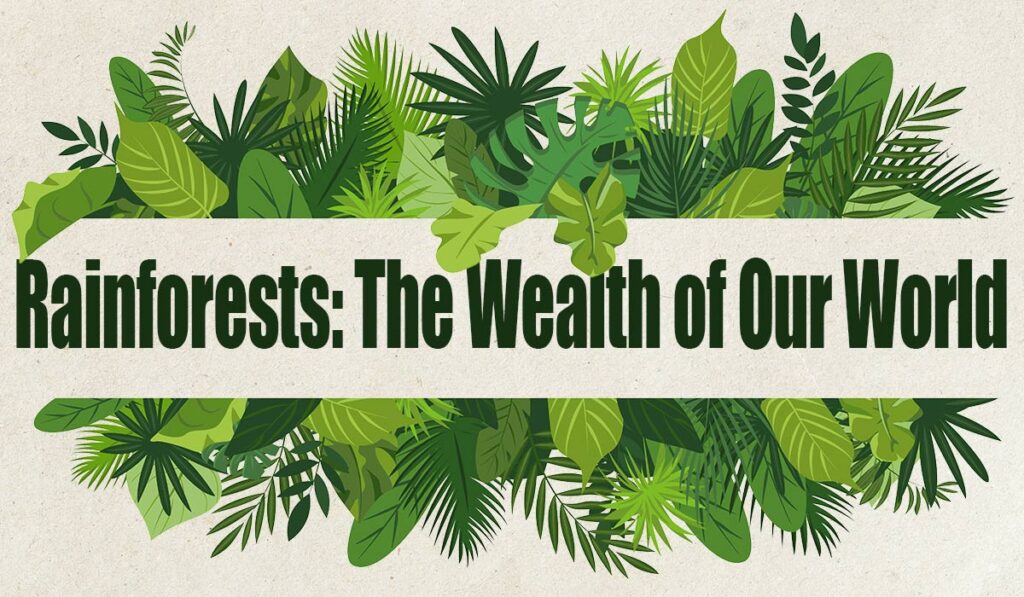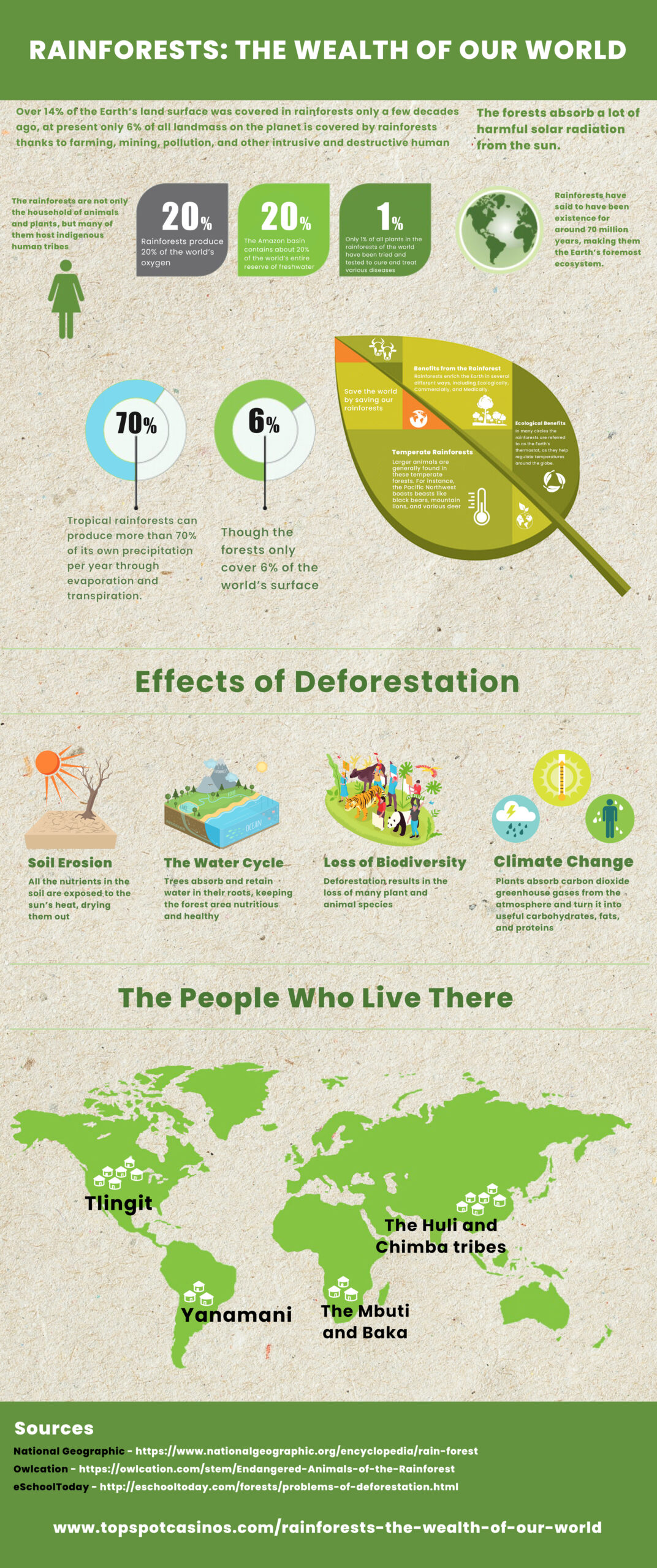Rainforests: The Wealth of Our World

The Earth and the way that it operates is a true marvel – one that scientists have been observing closely since the dawn of time. Nature is delicate artistry, that if left to its own devices, can thrive and provide a perfect balance to the ecosystems of the Earth.
One of the most important ecosystems on our Earth for the maintenance of life is the Rainforests, a natural resource that has come under huge threat in the past six to seven decades, despite increased awareness that conservation is essential to the Earth’s survival.
The various forests are teaming with life, but their benefit for the world surpasses their local impact, extending further to have global ramifications. To understand their importance in the macro scale of things, we need to understand more of the intricate details involved in each forest.
Rain Forests 101
Rainforests have said to have been existence for around 70 million years, making them the Earth’s foremost ecosystem. They are made up of large areas of evergreen trees and plants which get a high frequency of rainfall, sometimes up to 1,000cm per annum.
Though the forests only cover 6% of the world’s surface, they house about 80% of the world’s animal and plant species. Each forest ecosystem is extremely complex and diverse, housing a vast array of flora and fauna. According to National Geographic, a 10 square km / 4-square mile patch of forest can contain as many as 1,500 flowering plant types, 750 species of trees, 400 species of birds, and 150 species of butterflies. This is astounding on its own, but we have not even ventured to work out how many insect and animal types are included in those stats.
Types of Rain Forests
While Rainforests are unique when it comes to the type of plant and animal life they support, there are only two main types of these forests on our planet. These include Tropical Rainforests (such as the Amazon rainforests of South America) and Temperate Rainforests (such as the Atlantic Oakwood forests of Britain and Ireland).
Here are 5 features specific to each type of rainforest:
Tropical Forest:
- Very hot climate with temperatures of around 21 degrees to 30+ degrees Celsius (70- 80 degrees Fahrenheit).
- The humidity ranges between 75% and 88%, meaning that the forest stays both warm and wet.
- The humidity promotes frequent rainfall throughout the year, ranging up to 1,000cm per annum. In fact, tropical rainforests can produce more than 70% of its own precipitation per year through evaporation and transpiration.
- More than 50% of the world’s plant species are found in tropical forests, making them the most biologically diverse land-based ecosystems in the world.
- The Amazon Rainforest is the world’s largest rainforest. It, on its own, supports over
40,000 plant species, nearly 1,300 bird types, 3,000 fish species, 427 animals, and way over 2 billion insect species. A walk in the forest is never a noiseless affair if you take the chance to listen. The forest is full of life.
Temperate Rainforests
- Milder temperatures and lower humidity are experienced here than in tropical forests, with temperatures ranging between 10 and 20 degrees Celsius (50 to 70 degrees Fahrenheit).
- Temperate rainforests receive half as much rain as tropical forests do in a year.
- The cooler temperatures slow down the decomposition of leaves and foliage, resulting in way more ground cover than that found in tropical rainforests. It is said that approximately 2,000 tons of dead leaves, bark, wood, and other organic matter can be found on the ground per hectare.
- This unique ecosystem is specifically conducive to growing massive trees, such as Yellowwoods, Redwoods, and Alerce.
- Larger animals are generally found in these temperate forests. For instance, the Pacific Northwest boasts beasts like black bears, mountain lions, and various deer.
The dividing feature that usually determines whether a forest is tropical or temperate is its geographical positioning.
Tropical Forests are generally found in the tropics (between 23.5 degrees north and 23.5 degrees south of the equator), whereas Temperate Forests usually lie beside the coast or in the mountains along the mid-latitude lines.
Where primary tropical rainforests are commonly found in Central and South America, West and Central Africa, Western India, South East Asia, the Island of New Guinea, and Australia; temperate rainforests are found on the Pacific Northwest, North America, Chile, the UK, Japan, New Zealand, Norway, and parts of South Australia.
Many Systems, One Rain Forest
There is a high level of diversity within a rainforest, not just from one section of a forest to the next, but in the layers of the forest from the ‘floor’ to the ‘roof’.
The structure is split into 4 different sections, each sporting different flora and fauna.
1. Emergent Level
This is the very top layer of a rainforests plant life and consists of tall trees with little to no foliage in its mid-section, but many branches and leaves towards the top of the towering plants. The leaves are exposed to the direct sunlight, resulting in photosynthesis from the sun’s rays. Because it is exposed to the elements, these trees can retain large amounts of water, so they can weather droughts. The dispersion of
their seeds is aided by exposure to the wind. The emergent level is home to raptors, birds, gliders, bats, butterflies, and a few other light-weight animals inclined to high places.
2. Canopy Layer
This is a deep layer of vegetation just below the emergent level. It consists of several meters of thick vegetation and branches. This layer of trees protects the integrity of the forest, blocking out excess rain and sheltering the forest below from the wind and sunlight. Because it is so thick, it contains heat below the branches forming an extremely humid environment below. Because the canopy is not as exposed to the wind as the emergent level of trees, it must find other ways to disperse its seeds. Many of the trees at this level, therefore, render their seeds within fruit, which animals feed on and help disperse the seeds.
For this reason, this layer within the ecosystem is the most populous with animal life, including sloths, various ape species, lizards, and bigger birds like parrots, macaws, and toucans. The branches are also teaming with insect life, including beetles, bees, wasps, butterflies, spiders, and more.
3. Under Story
Several meters below the forest canopy is the penultimate layer of the forest referred to as the ‘Under Story’, where
shorter and more stubby plants reside. The leaves on this vegetation (like palms, etc) are much bigger than higher up in the canopy. This helps the plant absorb as much of the limited sun rays that escape past the two levels above as it possibly can. The plants tend to have larger flowers and stronger smells to entice insects to them to aid in pollination. In addition, most of the fruit on this level is edible to ensure seed distribution by animals found lower down towards the ground. Larger animals dominate this layer of the forest.
In the South American Jungles, you will find Jaguar and deer here, while Gorillas and Forest Elephants are known to habitat this area in the African forests. Other animals here, include snakes, bats, tree frogs, other amphibians, and more. It is on this layer than many of the world’s most endangered species reside, in easy access to poachers and hunters.
4. Forest Floor
This is the darkest area in the forest and is often some of the least nutritional areas in the forest. The decomposing leaves help make for rich topsoil, which means that most of the trees need a shallow root system to feed off the nutrients on the floor. Home to hordes of insects, you will find several smaller animals feeding off the substrate, including pigs, armadillos, anteaters, rodents, and predatory insects like spiders.
Included in this classification are any waterways found in the forest. The Amazon basin is home to the Amazon river, which teams with rich fish life of over 1,000 different types, including the infamous red-bellied piranhas.
The People Who Live There
The rainforests are not only the household of animals and plants, but many of them host indigenous human tribes.
Here is a list of some of the most thriving tribes in various rainforests around the world:
- Yanamani: This is a people from the Amazon forest between Venezuela and Brazil. They survive mostly on hunting and cultivation of the land.
- Tlingit: A North American tribe that survives mainly on their rich aquatic life for both salt and fresh-water fish species.
- The Mbuti and Baka: These tribes are often referred to in Western cultures as the Pygmies. They live traditionally as hunter-gatherers in the Central African rainforests.
- The Huli and Chimba tribes: Both from the island of Papa New Guinea, the Chimba are subsistence farmers, while the Huli people reside in the remote forest highlands and get by from hunting, gathering plants, and planting crops.
Most of these people have extraordinarily little to do with modern society yet some have been known to establish trade markets within their regions. Living off the land is their primary source of livelihood, but with an abundance of animal life, and vegetation, it is not as problematic as the Western mind might think.
One exciting possibility is that given the uncharted expanses of many rainforests, there is always the chance that there are undiscovered tribes who still live off the land and have no inkling of modern advancements and stresses.
Benefits From the Rain Forest
With such diverse ecosystems and rich life below the canopy, it is not difficult to imagine that rainforests can benefit the world, yet many people do not even realise the scope of their benefits. Rainforests enrich the Earth in several different ways, including Ecologically, Commercially, and Medically.
Ecological Benefits
Many people think that people chanting “save the world by saving our rainforests” is overly dramatic, but in fact, it is true. There are so many ecological benefits to rainforests that make an impact on the entire globe. Some of these include:
Rainforests produce 20% of the world’s oxygen, which is what we all need to breathe and stay alive. Ridding the world of rainforests would impact the world’s ability to sustain life.
The rainforests store a massive amount of carbon dioxide, which reduces greenhouse gas emissions. The forests absorb a lot of harmful solar radiation from the sun.
In many circles, the rainforests are referred to as the Earth’s thermostat, as they help regulate temperatures around the globe.
They help regulate rainfall around the world. Over half of the precipitation that reaches a rainforest will be returned into the atmosphere. They also store massive amounts of fresh water. The Amazon basin contains about 20% of the world’s entire reserve of fresh water.
Commercial Benefits
While over-cultivating the land has been a problem to this point, the fact remains that rainforests have rich resources for the commercial market, especially when it comes to wood and other resources. Mahogany, yellowwood, redwood, teak, rosewood, balsawood, and others are used daily in carpentry and joinery across the planet.
Medicinal Benefits
Naturally, everything we need for health and healing is found in nature. Only 1% of all plants in the rainforests of the world have been tried and tested to cure and treat various diseases. It makes one wonder what medicines may be
uncovered in the next few decades as science and research into medicine develop to cover more plant species.
Presently, medicines for many diseases are treated with the help of these naturally gleaned ingredients, including diseases like Arthritis, Asthma, Malaria, Heart Disease, and Pneumonia. Certain muscle relaxants, steroids, and insecticides are all formulated thanks to vegetation found in rainforests.
Cancer is one of the biggest plagues of the 20th and 21st century, yet 70% of medicines needed to treat this disease are found in these areas.
Threats Encountered
Over 14% of the Earth’s land surface was covered in rainforests only a few decades ago, at present only 6% of all landmass on the planet is covered by rainforests thanks to farming, mining, pollution, and other intrusive and destructive human.
Below are some of the effects of deforestation:
- Soil Erosion: All the nutrients in the soil are exposed to the sun’s heat, drying them out. Eventually, when the rain falls, it washes down the soil and results in massive erosion.
- The Water Cycle: Trees absorb and retain water in their roots, keeping the forest area nutritious and healthy. As stated before, a healthy rainforest ecosystem will release 50% of its precipitation back into the atmosphere to help regulate good rainfall. Removing forests means that much of this goodness is lost to the rivers and seas, and the rainfall patterns are changed.
- Loss of Biodiversity: Deforestation results in the loss of many plant and animal species. Daily, over 100 entire forms of life are being wiped into extinction because of human greed and deforestation. In the animal kingdom alone, some species are under huge threat of extinction. These include Proboscis Monkeys, Golden Lion Tamarins, Sun Bears, Gorillas, Poison Dart Frogs, Manatees, Chimpanzees, Harpy Eagles, Jaguars, Three-Toed Sloths, Hyacinth Macaws, Sumatran Tigers, and Pygmy Elephants.
- Climate Change: Plants absorb carbon dioxide and greenhouse gases from the atmosphere and turn them into useful carbohydrates, fats, and proteins. In return, they produce oxygen. Removing masses of plants and trees increases the carbon dioxide in the air, which means that climates in specific regions may change.
Human development and industry have been a massive threat to the safety of our world by this massive deforestation, affecting the planet in several ways. The main reason attributed to this deforestation surge has been Economic Inequality.
Rainforests are mostly in poorer countries, which are seemingly ‘prayed on’ by richer nations who push the demand for commercial resources up. To increase the economic standing of the forested country, they are forced to increase their yield in woods and paper, amongst others.
Conservation to the Rescue

Share this Image On Your Site
<p><strong>Please include attribution to https://www.topspotcasinos.com with this graphic.</strong><br /><br /><a href='https://www.topspotcasinos.com/casino-news/rainforests-the-wealth-of-our-world/'><img src='https://www.topspotcasinos.com/wp-content/uploads/2023/09/15-5-Final-version-sml-scaled.jpg' alt='Rainforest infographic' width='2500px' height='5969px' /></a></p>